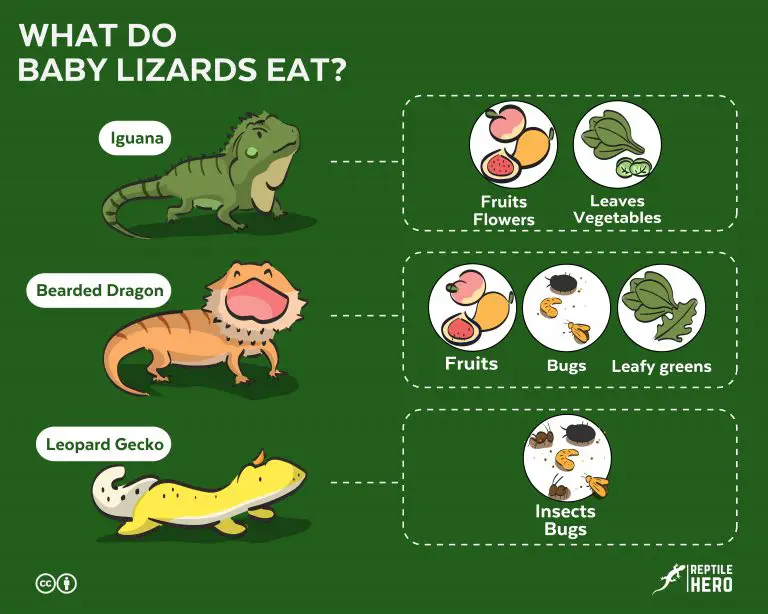The 8 Differences Between A Newt And A Leopard Gecko [+ Fun Fact!]
When it comes to popular pets housed in tanks, newts and leopard geckos always make it to the list. After all, they look similar to each other. But whether you are a first-time pet owner or an experienced one, which of the two should you consider having and adding to your family?
Leopard geckos and newts are space-friendly pets. However, they have eight significant differences to take into account:
- Biology
- Appearance
- Food
- Enclosure
- Handling
- Maintenance
- Behavior
- Distribution
| Feature | Newts | Leopard Geckos |
|---|---|---|
| Biology | Amphibian group – many lifecycle | Reptile group – one lifecycle |
| Appearance | Bright and vivid markings often with smooth, moist skin or dry, warty skin | Textured skin with vibrant colors, distinct patterns, and unique eye features |
| Food | Live prey like slugs, worms, and brine shrimp | Live prey like crickets and worms |
| Enclosure | Either fully- or semi-aquatic | Always terrestrial |
| Handling | No handling | Minimal handling |
| Maintenance | Weekly | Daily, weekly, and monthly |
| Behavior | Either diurnal or nocturnal | Crepuscular |
| Distribution | Asia, Europe, North America, and North Africa | Afghanistan, India, Iran, Nepal, and Pakistan |
Stay with us as we learn more about their differences.
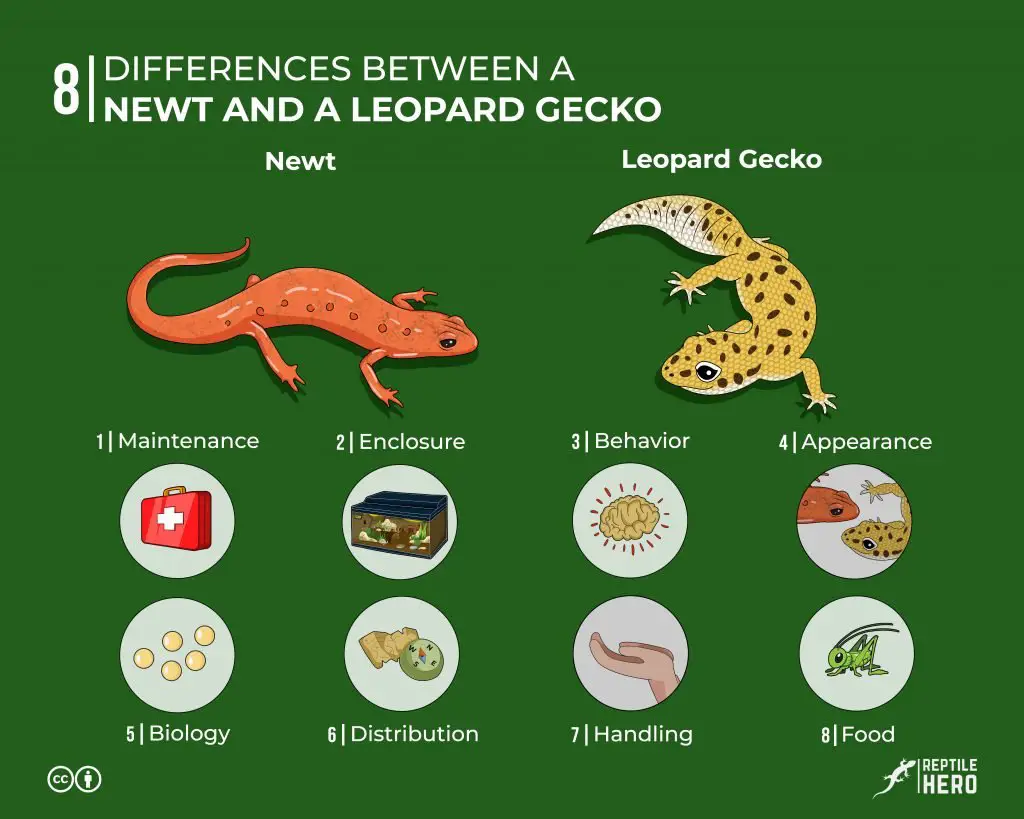
A Newt Or A Leopard Gecko?
Though, as a gecko enthusiast myself, I would personally recommend leopard geckos. But newts are just as fantastic and as unique of a pet as geckos are.
If you are one of the handfuls of undecided people, let me help you decide which of the two you should consider! Below are eight differences I will further discuss.
1 – Biological Differences
Whether you get a newt or a leopard gecko, you must know their biological differences as a responsible parent to either of the animals.
Class Group
Newts and leopard geckos may look alike for most of us who are unaware of the details. But their biology works in a contrasting manner because they belong to different class groups.
Newts
Newts have grown to become popular vivarium pets over the past decade. You might associate them with geckos because of their resemblance. However, they are not. They belong to the class Amphibia, just like frogs, which live alternately between land and water.
Is a newt a salamander?
Yes. A newt is always a salamander. However, a salamander is not always a newt.
Wow, that was confusing, right? Actually, the term “salamander” is a name that comprises amphibians that have tails as adults. And one of the groups that feature this characteristic is newts!
There is only one distinction that is always true between a salamander and a newt.
For a salamander to be called a “newt,” it must belong to one of these genera:
Fully-Aquatic Newts:
Perennibranch individuals (those that retain gills all their life) of:
- Ichthyosaura (formerly named as Mesotriton)
- Notophthalmus
- Lissotriton (formerly belongs to Triturus)
- Ommatotriton (formerly belongs to Triturus)
Semi-Aquatic Newts:
- Calotriton (formerly named as Euproctus)
- Cynops
- Echinotriton
- Laotriton (formerly belongs to Paramesotriton)
- Neurergus
- Pachytriton
- Paramesotriton
- Pleurodeles
- Taricha
- Triturus
- Tylototriton
While they are roughly classified as such, there are still a lot of changes and exceptions. Whether they indeed are fully- or semi-aquatic, the 15 genera (and still growing) encompassing the group of newts are full of surprises!
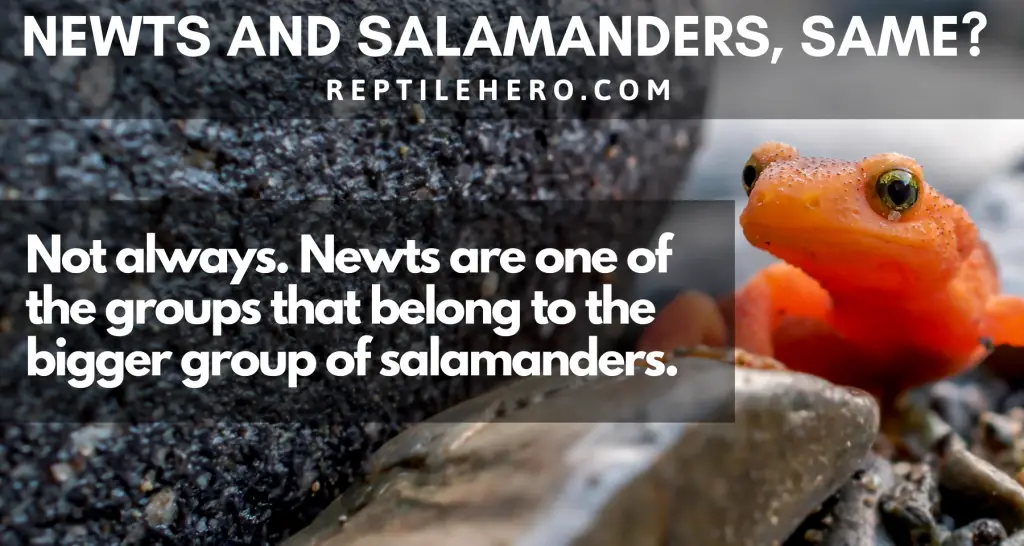
Depending on the species you would own, some would take both simultaneously, while others would alternate between the two at different stages in their lives. Others would love the cold climate, while some prefer the tropical weather.
Apart from this, you would find that some newt species do great in groups. On the other hand, others are highly aggressive against tankmates, even within the same species. With the opposing and varying levels of care that each species requires, you must do a great deal of research to provide the optimum care.
Leopard Geckos
One way or another, you might have heard of leopard geckos at some point in your life, or perhaps you already own one (if so, well done!).
Leopard geckos do not belong to the same class as newts. They are related to more enormous lizards like iguanas, Komodo dragons, and monitor lizards.
Leopard geckos are from the class Reptilia, which has distinct dry, scaly skin. Referring to three of the five species in the genus Eublepharis, they are land lizards with moveable eyelids. So, you would often see them blink as you do. What is more to this is that you would see them sleeping with their eyes closed!
Another thing is that leopard geckos can grow a tail anew. This life-saving technique allows them to escape during predator attacks. Not only that, the tail—even the newly developed—also serves as fat storage. Anytime, it is ready to supply the gecko when there is little food.
| Taxonomy | Newts | Leopard Geckos |
|---|---|---|
| Kingdom | Animalia | Animalia |
| Phylum | Chordata | Chordata |
| Class | Amphibia | Reptilia |
| Order | Caudata | Squamata |
| Family | Salamandridae | Eublepharidae |
| Subfamily | Pleurodelinae | N/A |
| Genus | 15 genera as listed above | 1 genus: Eublepharis |
Life Cycle
Knowing how different the two animals are classified biologically, you might wonder how different their life cycles are.
Newts
Since newts have many different species, no one life cycle describes them all. As each is unique on its own.
Here are the most common life cycle of newts:
- Some species breed, lay their eggs, and hatch on land.
- Other species breed and lay eggs in the water and hatch on land.
- Some species have eggs that hatch, with larvae that grow up in the water before heading to the land as adults.
- Still, others spend all the stages of their life cycle in water.
- While other species have eggs that hatch directly into tiny newts, skipping the larval stage altogether.
However, despite the many differences, newts generally develop and evolve in three distinct stages.
Newts lay hundreds of eggs. But for some species, it does not mean that those came from a single male. As a matter of fact, some females can store sperm in their sperm storage glands called spermathecae [1].
For instance, a female newt could lay about 300 eggs during one breeding season! That is a lot of eggs. What is more tedious is that the female individually wraps the eggs between a water plant leaf’s folds. This egg-laying process definitely takes many hours to finish.
When newts hatch from eggs, the babies are called tadpoles (Yes, the same tadpoles in frogs!) and begin life as aquatic larvae. These tadpoles have a resemblance to baby fish with feathered external gills.
In spite of their many species, newts are not as widely bred in captivity as leopard geckos. Over the years, newt breeders are also not as sex-conscious as opposed to leopard gecko breeders. As a result, anecdotes about temperature-dependent sex determination in newts are not as rampant as leopard geckos.
Most reptiles—including leopard geckos—and many fishes manifest temperature-dependent sex determination [2]. However, a study conducted by Dr. Hugh Wallace on Triturus cristatus (crested newts) showed these exciting results [3]:
- Incubation temperatures between 64.4 and 75.2°F produced equal males and females.
- Incubation temperatures higher than 75.2°F produced more males.
- Incubation temperatures lower than 64.4°F produced more females.
As they grow into the terrestrial juvenile stage called efts, they slowly evolve lungs and mainly stay on land. However, you should know that some species do not undergo this phase and would immediately become adult newts.
Much like other amphibians, newts evolve into their adult form. During this stage, they have more prominent and more pronounced lizard-like bodies. At this phase also, they are now more equipped to breathe in the air on land.
The whole maturation process usually takes around four to six months. Again, depending on species and under ideal conditions, it may take as long as two to three years or as short as two to three months. But you have to upgrade the tank size as your amphibian grows.
Leopard Geckos
When you recall how complicated a newt’s life cycle is, you do not have to think much about the leopard geckos.
Are gecko and newt life cycle the same?
Leopard gecko starts with an egg that hatches into a hatchling, then grows into a baby and a juvenile, then matures into an adult. All of which stays on land at all times. Different from newts, geckos have only one type of lifecycle.
What is more interesting is that female leopard geckos can even store the sperm—like newts—for later use! If they do not feel like laying eggs, they can postpone the process until they deem fit for it. When the right time comes, they typically lay a clutch of two eggs, although a single egg in a clutch is not uncommon.
Generally, females can lay three to five clutches. However, some breeders reported having gotten eight clutches in one season. That is a lot! Besides, incubating also takes quite some time as some hatches as fast as 35 days while others can take up to 90 days. But it really depends on the conditions.
Another interesting fact I find amazing is how leopard gecko’s sex is decided. Like most reptiles, incubation temperature plays a vital role in determining whether an egg develops into a male or female hatchling.
For breeders, they follow these tips to produce their preferred sexes:
- Incubation temperature at 80°F produces 100% female hatchlings.
- Incubation temperature at 90°F produces around 98% male hatchlings.
- Incubation temperatures around 87°F will give an equal number of males and females.
When leopard geckos hatch from the eggs, they are called a hatchling. But after hatching within their first month, they are considered a baby. During the first few days, they are better off with the egg yolk until their first shed. They would then eat the shed skin and survive another day.
As they grow into a juvenile within the first ten months, they are now ready to hunt for insects. During this stage, they tend to grow at a rapid rate, so you should not be surprised to see your gecko gain a couple of grams in a week. Do not worry; your gecko is not overweight.
After more than 12 months, leopard geckos are now adults. But even if they are now adults, these geckos can still keep growing until 18 months from their birth. Also, they are now capable of reproducing if you plan to breed them.
Otherwise, you can keep them as pets and continue providing good care.
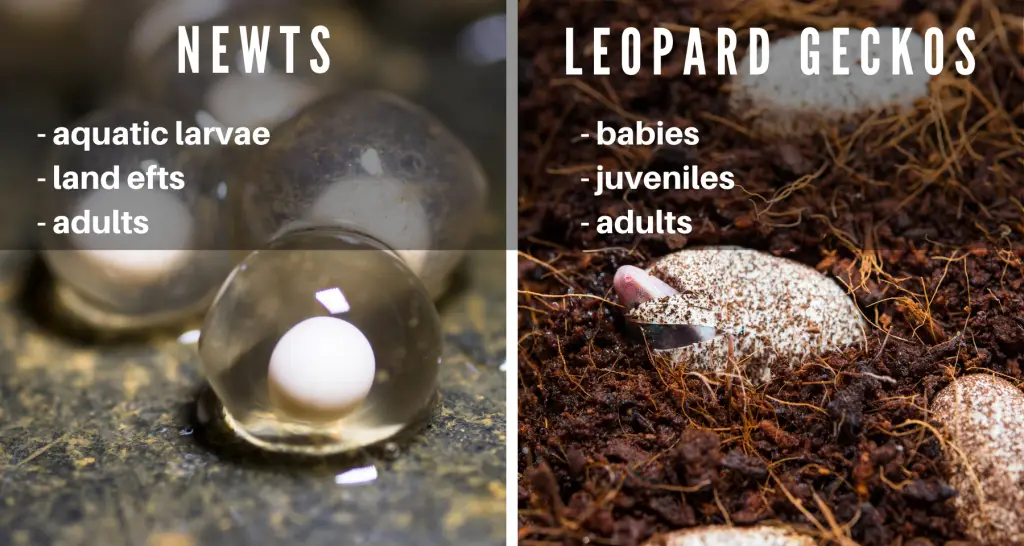
2 – Physical Differences
Newts and leopard geckos are ideal pets for people who do not have space for larger animals. While both are similar in size as adults, they have significant physical differences you should know.
Appearance
While others might say, “Appearance does not matter. Personality does,” it is definitely essential that you should still get the pet most appealing to your eyes.
Newts
Like most salamanders, newts are often seen as offspring between a frog and a lizard. I mean, who would not mistake them for one? They have dry, warty skin like frogs and long tails like lizards.
But newts are entirely different from the two. While they have four equal limbs and a tail, their body is covered with semipermeable glandular skin. Although their skin is not as smooth as that of other salamanders, newts still need to keep their skin moist. Since their skin quickly dries out when the weather is too hot, they tend to stay near bodies of water for moisture.
Of course, there are several exceptions! Since newts are a large group with a lot of species, no one description fits everyone:
- Some species have better eyesight in the dark.
- Other species have eyes that are better in the day.
- Some species have the usual rough and grainy skin.
- Other species have distinct smooth and moist skin.
- Some species have evolved fleshy toes at the end of each foot.
- Other species have adapted to fully webbed feet with very short toes.
- Most species have developed lungs, allowing them to live above ground.
- Other species have retained their gills and preferred to live underwater.
While leopard geckos are commonly bred by experts to create new morphs, newts are almost always harvested from the wild. As a result, typical skin colors found in the wild—green, black, or brown—are what you should expect. Other markings, like bright patterns around their body, are also typical naturally.
Leopard Geckos
You might have guessed it right. Leopard geckos have leopard-like spots all over their back. To some extent, these spots become thick horizontal bonds rather than circular ones.
The leopard geckos’ body structure includes a small triangular-shaped head with a long, wart-like textured body and a thick, segmented tail. Their underbelly is smooth, without distinguishing marks. Furthermore, their four limbs are also slender.
What sets them apart from other geckos is that they have clawed toes. These are unusual to other species that feature the more common sticky toe pads. Thus, you would often observe leopard geckos above ground, hiding under rocks, climbing on logs, and basking atop boulders.
Some people do not prefer their textured backs, bland and dull visual features, typical patterns, and boring pupils. So, you may find one that has utterly smooth skin. Experts would even selectively breed new morphs that manifest vibrant colors, distinct patterns, and unique eye features!
Size and Weight
Both newts and leopard geckos do not grow considerably big, so an area for at least a 10-gallon tank is all you would need. Even so, below is a table of their possible average lengths and weights upon maturity that you should know.
| Difference | Newts | Leopard Geckos |
|---|---|---|
| Average adult size, inches | 2 – 8 | 6 – 9 |
| Average adult weight, grams | 6 – 227 | 50 – 80 |
| Lifespan in captivity, years | 10 + | 20 + |
Despite being very popular vivarium pets, newts and leopard geckos demand opposing care and attention. Indeed, their 1) food and diet, 2) enclosure, 3) handling, 4) maintenance, and 5) behavior are distinct from one another.
3 – Food and Diet
Knowing how biologically different the two animals are, you would expect them to have different food and dietary demands. But both pets have one thing in common: they love to hunt their prey.
| Difference | Newts | Leopard Geckos |
|---|---|---|
| Classification | carnivore | carnivore (specifically insectivore) |
| Feeding Frequency | every day (juvenile) every other day (adult) | every day (baby) every other day (juvenile) every other two days (adult) |
| Supplements | dust food daily with calcium supplement and once or twice a week with a multivitamin supplement | dust food daily with calcium supplement and once or twice a week with a multivitamin supplement |
Newts
Food – Newts are best fed at night when they are most active. As a carnivore, they love to feed on live preys that are recently gut-loaded, such as:
- slugs
- crickets
- Daphnia
- waxworms
- water fleas
- earthworms
- bloodworms
- brine shrimp
- nightcrawlers
Water – For semi-aquatic newts, you have to provide a dish to serve as a water bowl. You should be careful and must only fill the bowl with dechlorinated water. Some potential and valuable sources are:
- Bottled spring water: available at the supermarket
- Hot water: boil for a few minutes, then cool down
- Filtered tap water: run through a tap water filter attached to the faucet
- Aged water: sit in an open container for 24 to 48 hours to evaporate chlorine
Leopard Geckos
Food – Leopard geckos are most active during dusks and dawns, so you should aim to feed them during these hours. As a carnivore, they would appreciate live insects. But there are times when tong-feeding is a must, especially for babies and juveniles. Some of their favorite insects are:
- crickets
- silkworms
- waxworms
- hornworms
- mealworms
- superworms
- butterworms
- Dubia roaches
Water – Leopard geckos are land-dwelling creatures, so you should supply its tank with a small and shallow dish as a water bowl. This prevents your reptile from drowning. The water must always be:
- fresh
- clean
- chlorine-free
4 – Enclosure Demands
Both newts and leopard geckos live inside a tank as pets. But their enclosure setups are on the opposite ends of the spectrum. As a future owner, it is your responsibility to mimic what their natural habitat has to offer.
To help you distinguish their enclosure demands, see the table below for their differences.
| Parameter | Newts | Leopard Geckos |
|---|---|---|
| Tank Size | at least a 10-gallon waterproof tank | at least a 20-gallon tank |
| Tank Orientation | floor space is more important than height | floor space is more important than height |
| Landscape | must have good hiding spots like large shards of pottery and pieces of bark, rocks, and store-bought decors | must have a lot of hiding areas under branches, corks, logs around the tank |
| Substrate | must use a combination of dampened moss and shredded bark, or coconut fiber | must use a mixture of paper towel, rough, flat slate pieces, and terrarium carpet |
| Waterscape | must have hiding areas like aquatic plants, barks, and rocks | N/A |
| Water Substrate | must use a large smooth gravel or slate with plants | N/A |
| Water Filtration | must provide a mechanical, chemical, or biological filtration | N/A |
| Temperature | must provide a temperature gradient, where one side is at 60°F while on the other end is at 75°F. | must have a basking area at 95°F and a cool-end spot between 78 and 88°F |
| Heat Source | must have aquarium water heaters, heat lamps, or heating pads | must have an under-the-tank heater (UTH) pad |
| Humidity | must maintain 70% humidity by misting as needed every day | must maintain humidity below 50% |
| Lighting | must provide lighting for 10 to 12 hours a day | must provide 10 to 12 hours of light per day |
| Light Sources | must use a UVB light with full spectrum | must give a cool-white incandescent basking bulb and a UVB full-spectrum bulb |
Special Requirements of Newts:
The information above gives a distinction between what newts and leopard geckos need. But while the table above is generally valid for newts, more tank specifications need emphasis.
For Fully-Aquatic Newts:
- Place two inches of clean aquarium gravel at the bottom of the tank.
- Build the gravel level in a sloping manner up to three inches at the back.
- Plant some aquatic plants for a pleasing environment.
- Add a minimum of eight inches (and a maximum of 19 inches) of water above the gravel.
For Semi-Aquatic Newts:
- Divide the tank into two parts.
- Decide which side will have water.
- On the water side, fill it with 0.5 inches of aquarium gravel.
- Create a gentle slope, building up to the land side.
- On the land side, put at least two inches of gravel at the bottom of the tank.
- Add the soil of choice.
- Maintain land side temperature between 65°F and 80°F, with 60 to 80% humidity.
For Tropical Newts:
They typically require particular heating to attain and maintain their specific temperature demands.
5 – Handling and Safety
Of course, you would want to occasionally cuddle or handle your pet. I mean, why would you own a dangerous pet. Right? Although both newts and leopard geckos are safe for handling to an extent, you should still be aware of the risks these small pets could pose to you.
Newts
Ever wondered what those bright colored markings on their skin are? Those are indicative signs that they are toxic. So basically, you are recommended not to handle newts during any circumstance. That is because they are known to secrete toxins—such as tetrodotoxin—which protect them from predators in the wild [4].
Even as pets in captivity, they continue to produce and excrete this toxin which could cause stomach problems and muscle paralysis. And at higher doses, the poison could be lethal to humans [5]. However, if you really need to pick up your newt, you must:
- wear medical-grade gloves
- dispose of the gloves properly
- wash hands thoroughly after handling
While you might think that your newt is the only one hurting you, you are wrong. Newts are also sensitive and delicate pets. You might find this strange, but the soap, rubbing alcohol, or even oils on your palms could actually cause skin irritation to your pet.
If you are the person who fancies not handling your pet, a newt would be best for you since it does not necessarily demand handling, grooming, hugging, or petting to make them happy.
Leopard Geckos
Knowing how newts can become unsafe and even deadly to you, a safer alternative like leopard geckos can be just as great of a pet. To add, these geckos can manage minimal handling from you.
You might have the wrong impression that picking up your gecko is as easy as 1-2-3. But you should know that there is actually a correct way to do so. Before I mention the tips, you should note by heart never to get it by the tail. Otherwise, it will drop off!
So when handling your gecko, you can follow the tips below:
- Start by placing a flat hand down.
- Ease it onto your palm.
- Hold it with a flat hand while supporting its legs and tail.
- Stroll with it slowly.
- Start with a five-minute handling session.
- Continue until it is comfortable.
When anything goes wrong, your nervous gecko would surely let you know by its body language. You might hear its bark, see its wagging tail, or witness it run away. If this happens, you better leave it alone and try your luck again next time.
Even though leopard geckos are relatively safer than newts, you still have to handle them with caution as poops are known to transmit salmonella to humans. Always wash your hands whether you own geckos, newts, or other pets.
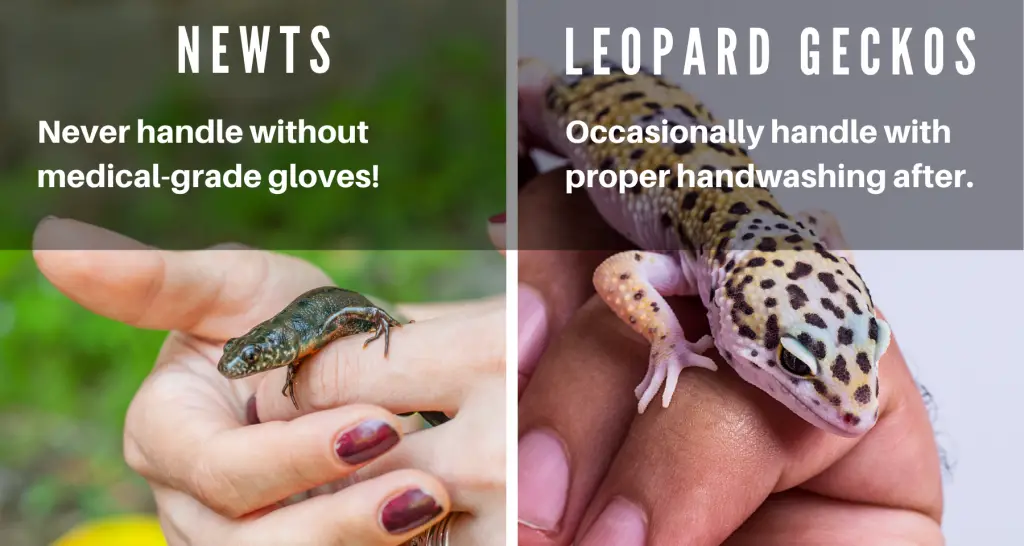
6 – Maintenance
Another notable difference worth mentioning is their tank maintenance. Even though both newts and leopard geckos share more or less the same tank size, the care substantially varies.
Newts
The water element in the newts’ vivarium makes it prone to fungus and algae, so it is most efficient to only perform a deep cleaning to save your effort.
Frequency of Thorough Cleaning: At least once a week
- Place the newt in a secured temporary critter box.
- Scrub the tank and furnishings.
- Rinse rigorously with hot water.
- Dry the tank and furnishings completely.
- Add a clean substrate for the land and water side.
- Fill the water side with dechlorinated water.
Leopard Geckos
What makes leopard geckos ideal is that their tanks can be self-sustaining to an extent. But you should still perform your cleaning duties as the owner.
Frequency of Spot Cleaning: Once a day
- Remove any poop.
- Remove uneaten insects.
Frequency of Light Cleaning: Once a week
- Replace the substrate if using paper towels
- Clean the substrate with soap if using carpet
Frequency of Thorough Cleaning: Once a month
- Transfer the gecko into a secured container.
- Remove all accessories and substrates.
- Wash the inside of the tank and the accessories.
- Dry out the tank and accessories.
- Add a new substrate.
- Replace the accessories.
7 – Behavioral Differences
Like how moving into a new home stresses us out, transferring a newt or a leopard gecko into a new tank also causes discomfort to the pet. So, you have to remember that your amphibian or reptile might skip meals during the process.
Newts
Newts are not the cuddly pets you would want to have. They prefer to be untouched. When new to the enclosure, they tend to take three to five days to adjust. Until they have cozied up, you would observe them be active when they want to.
Since newts have many species, you could own either a diurnal (active during the day) or a nocturnal (active during the night). Regardless of when they are busy, they would spend most of the waking time hunting for food or chilling by the tank’s cool area.
Like geckos, newts tend to eat their shed. So, be calm if you have not seen any skin shavings. It is perfectly normal. Besides, you should also observe your pet to be less active during shedding. The process commonly uses up a lot of their energy, so moving around less is their way to conserve energy.
Some newts are found in colder climates in the wild, so they do hibernate even in captivity. So, you must allow them to bury themselves underground during winter. If you let them complete the process annually, this somehow increases their life span.
Leopard Geckos
In the wild, leopard geckos spend most of the daytime hidden under the ground or under crevices. As dusk approaches, you would then find them up and about, hunting for insects and avoiding predators.
If you own one anew, these crepuscular geckos could take as long as 30 days to acclimate in the new environment. However, they would surely enjoy exploring the vast tank when they have warmed up, especially during dusk and dawn.
At their own slow pace, they may explore your arms, hands, head, and shoulders when handled. Although they are less clumsy than you expect them to be, their gentle disposition feeds you this idea. So, whenever you scoop them, remember that they can bite too!
8 – Other Differences: Distribution
Newts
Because newts comprise many species, they can be found worldwide, particularly in the Northern Hemisphere. You might find some living on the land in North America or Europe. Meanwhile, you can also find others living almost exclusively in the bodies of water in Asia or North Africa.
Leopard Geckos
All leopard geckos naturally inhabit the rocky grasslands and dry deserts of Afghanistan, India, Iran, Nepal, and Pakistan. This region is famous for having minimal precipitation and sparse vegetation [6]. Contrary to popular belief, they actually avoid areas where sand is the primary substrate.
Fun Fact!
As a Salamandridae family member, newts have the surprising ability to regrow and regenerate lost limbs and tails with fully functional ones. What is more is that they can grow lost external and internal anatomies—like heart muscles, cells in the nervous system, and lens of the eyes! [7]
Interested to see how it works? A time-lapse animation below shows what a 90-day limb regeneration looks like.
Looking For Another Comparison?
There are more common pets a leopard gecko can be compared with. You might be interested to know the comparison of leopard geckos vs. crested geckos. Otherwise, you may want to read on leopard geckos vs. bearded dragons.
Takeaways
Newts belong to amphibians, noted by their delicate skin and ability to live both on land and water.
Meanwhile, leopard geckos are under the reptiles class known to have scaly and armored skin that thrives in arid regions.
Unlike leopard geckos that are selectively bred in captivity for visual features, newts are almost always wild-caught and rarely bred.
Both newts and leopard geckos are carnivores. However, due to their biological nature, newts are stricter when it comes to water quality.
While both animals require a tank as their home, newts must have a water side to compensate for their amphibian-related needs.
Leopard geckos tend to tolerate occasional handling with little to no risk to their owner. Meanwhile, newts should never be handled at all costs since they pose a high risk of toxicity on their skin.
Maintaining leopard geckos and newts entails varying levels of care. Clean the tank as recommended to provide optimum living conditions.
Both newts and leopard geckos need an ample amount of time to acclimate to their new environment. Once they are comfortable, they enjoy exploring the tank at their own pace.
Sources
[1] https://www2.southeastern.edu/Academics/Faculty/dsever/Severetal2001.pdf
[2] https://embryo.asu.edu/pages/temperature-dependent-sex-determination-reptiles
[3] https://pubmed.ncbi.nlm.nih.gov/11128575/
[4] https://elifesciences.org/articles/53898
[5] https://www.poison.org/articles/poisoning-from-amphibians-204
[6] https://animaldiversity.org/accounts/Eublepharis_macularius/
[7] https://www.nature.com/news/newt-sequencing-may-set-back-efforts-to-regrow-human-limbs

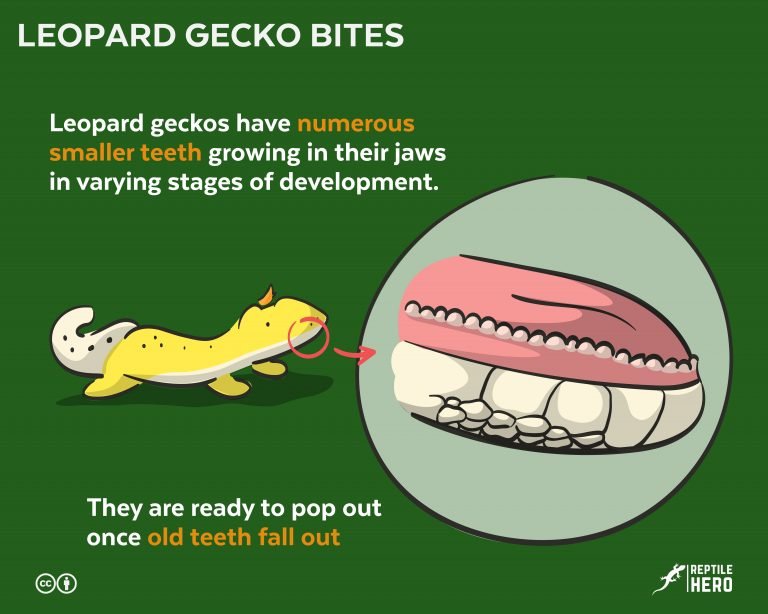
![Why Does Your Gecko Lick? [You, Themselves, and Other Objects]](https://www.reptilehero.com/wp-content/uploads/2021/05/gecko-lick-object-cc-768x614.jpg)
![Is House Gecko’s Bite Dangerous? [and What To Do]](https://www.reptilehero.com/wp-content/uploads/2022/05/house-lizard-bite-dangerous-cc-768x614.jpg)

![How Fast Does A Gecko Decompose? [4 Factors]](https://www.reptilehero.com/wp-content/uploads/2021/04/How-long-does-it-take-gecko-to-decay-infographic-768x614.jpg)
